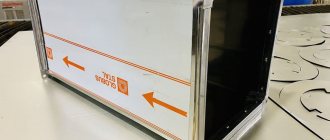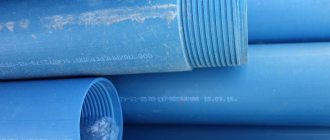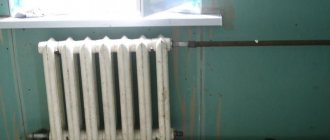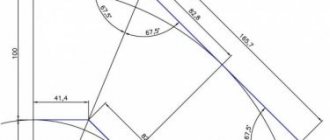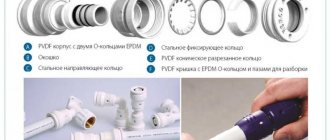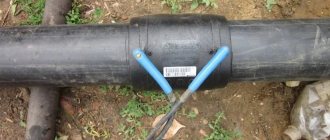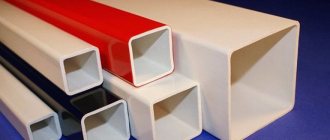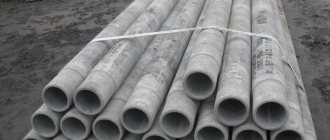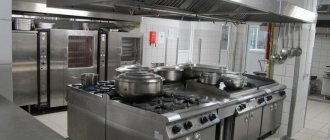General rules
The air duct system must provide a number of functions, for which the ducts must have the following qualities:
- heat and sound insulation
- tightness of connections, tightness
- installation in unused areas of the premises, compactness
- resistance to all loads, both external and internal, strength
The rules for installing air ducts are set out in SP 60.13330 (Heating, ventilation and air conditioning) and in SP 73.13330.2012 (Internal sanitary systems of buildings). They set out the standards and requirements for installation, define acceptable parameters and types of load-bearing structures. In particular, the need for installation away from hot surfaces or installations and the presence of grounding are indicated.
The rules for connecting and hanging all types of air ducts have been established, and the rules for hanging from a ceiling slab or load-bearing element have been determined. Particular attention is paid to duct sealing practices to reduce leaks or losses and improve system performance.
Standard distances
Air ducts are attached to different surfaces:
- ceiling slab
- ceiling trusses or load-bearing elements attached to them
- walls
- floor
When installing the system, the following standards must be observed:
- the distance from round air ducts to the ceiling must be at least 0.1 m, and to walls or other elements - at least 0.05 m
- the distance between round air ducts and communications (water supply, ventilation, gas lines), as well as between two round air ducts should not be less than 0.25 m
- from the surface of the air duct (round or rectangular) to the electrical wires there must be at least 0.3 m
- the distance from the surface of rectangular air ducts to the ceiling must be at least 0.1 m (for air ducts with a width of up to 0.4 m), at least 0.2 m (for ducts with a width of 0.4-0.8 m) and at least 0 .4 m (for air ducts 0.8-1.5 m wide)
- all channel connections are made no closer than 1 m from the point of passage through the walls, ceiling or other structural elements of the building
The axes of the air channels must be positioned parallel to the planes of the ceiling slabs or walls. Exceptions occur when ducts transition from one level to another or in the presence of equipment, protruding elements of the building structure, which do not allow the installation of air ducts parallel to the plane of the building structure.
In addition, it is allowed to install pipelines at a slope of 0.01-0.015 towards drainage devices if the transported medium is prone to condensation.
Tasks and design of the ventilation passage
The main purpose of a roof air exchange unit is to extract exhaust air. And the installation of the system is carried out on the basis of the GOST-15150 standard. It contains information about how close the ventilation passage will be located to the edges of the slab, and also sets the standard size of openings in floor slabs. Such ventilation elements are also used for chimneys that are installed in buildings with fireplaces or stoves.
In order to arrange a ventilation outlet for metal tiles, we will need a whole list of materials:
- a set of aluminum units for ventilation;
- fastening anchors;
- fire-resistant material, for example, glass wool;
- metal glasses;
- thermal insulation material, for example, mineral wool;
- roof rafters made of wood;
- industrial standard tool set.
Ventilation on the roof is divided by shape and can be square, oval, round or rectangular, which will depend on the type of roof and exhaust ducts.
Example of a round ventilation outlet
Ventilation outlets are openings created in the ceilings that allow pipes to be brought out onto the roof, into the attic. Aluminum pipes are inserted into them, then built into the roof of the house itself. In this case, it is better to use aluminum sheets with a thickness of 1 mm or more. Ventilation systems are sold in a wide range of sizes, from which you can easily choose the most suitable one. At the same time, ventilation systems that use metal pipes are divided into natural and forced. And in order to select the necessary elements of the passage, you need to focus on some nuances:
- humidity level;
- volume of gas emissions;
- maximum and minimum temperatures;
- the amount of dust and dirt generated.
The roof ventilation passage using reinforced concrete is mounted on anchor bolts, which are placed in glasses for installation. And during installation, you need to take into account the level of roof slope and the distance between the penetration and the roof ridge. Also important parameters will be the thickness of the ceiling itself and the building material from which the roof and roof structure are made. Not least important is the size of the room located under the roof. The installation of a ventilation pipe often depends not on the space on the roof, but on what is located under it, because that is where all the additional components and communications are always located.
If the width of the opening is not enough for a solid ribbed or hollow slab, then zones of monolithic concrete can be made in the passage areas.
Ventilation on a roof with aluminum sheathing is done in a similar way, but using metal cups. It must be said that in buildings with a lot of premises for industrial or residential purposes, the passage unit must be provided in the building plan itself.
When installing ventilation through the metal roof itself, and when the shaft is located in the attic area, you need to make sure that certain elements are present in the passage, namely, a pipe that is connected to the supporting flange. This element is attached to a metal glass with anchors, and for the greatest reliability of the units, they are fastened with clamps. As a result, we see a constructed ventilation unit that can function normally.
Materials for the production of galvanized steel air ducts
Depending on the characteristics of the object and operating conditions, the following materials can be used:
Thin-sheet cold-rolled steel 0.5-1 mm thick. This material complies with GOST 14918-80 (one-sided galvanizing of the surface, the consumption of which is 200-420 g of zinc per 1 m² of sheet). It is suitable for use under normal conditions and low environmental aggressiveness. The maximum permissible temperature of transported air is 80 °C (short-term - no more than 200 °C) with humidity up to 60%.
Thin-sheet cold-rolled steel 1–2 mm thick. It can be used to produce metal air ducts for ventilation designed for constant air temperatures up to 200 °C. For more severe operating conditions, it is recommended to use products made of galvanized steel.
Prices for rectangular galvanized ventilation ducts
| S | A*B | Air duct L=»1250 | 45° bend | 90° bend | Stub | Umbrella | Straight insert | Throttle valve | Shiber | Flexible insert |
| mm | mm | rub/mp | rub/mp | rub/piece | rub/piece | rub/piece | rub/piece | rub/piece | rub/piece | rub/piece |
| 0,5 | 100*100 | 508,1 | 355,25 | 478,23 | 204,04 | 481,67 | 199 | 716,92 | 775,42 | 272 |
| 150*100 | 617,59 | 382,11 | 530,7 | 228,04 | 545,82 | 224,1 | 803,49 | 911,45 | 316 | |
| 150*150 | 721,91 | 445,09 | 617,65 | 277,94 | 719,67 | 259,32 | 1082,69 | 1120,73 | 360 | |
| 200*100 | 736,46 | 425,98 | 609,07 | 245,22 | 629,01 | 250,29 | 899,98 | 1069,27 | 360 | |
| 200*150 | 843,2 | 486,52 | 694,58 | 298,26 | 775,46 | 284,01 | 1210,51 | 1307,65 | 404 | |
| 200*200 | 949,94 | 547,07 | 780,09 | 351,3 | 996,12 | 317,72 | 1562,95 | 1546,03 | 448 | |
| 250*100 | 848,85 | 480,95 | 706,23 | 262,67 | 697,39 | 278,9 | 949,89 | 1166,20 | 404 | |
| 250*150 | 956,41 | 541,39 | 793,4 | 318,92 | 848,59 | 311,89 | 1273,00 | 1419,53 | 448 | |
| 250*200 | 1063,96 | 601,84 | 880,58 | 375,18 | 1013,34 | 344,87 | 1634,40 | 1672,86 | 492 | |
| 250*250 | 1171,51 | 662,29 | 967,75 | 431,43 | 1238,34 | 377,86 | 2034,09 | 1926,19 | 536 | |
| 300*100 | 961,58 | 540,08 | 810,98 | 281,53 | 784,46 | 309,03 | 996,1 | 1258,47 | 448 | |
| 300*150 | 1069,77 | 600,94 | 900,35 | 341,42 | 937,35 | 341,66 | 1330,67 | 1526,59 | 492 | |
| 300*200 | 1177,97 | 661,79 | 989,73 | 401,31 | 1102,83 | 374,29 | 1700,58 | 1794,70 | 536 | |
| 300*250 | 1286,17 | 722,65 | 1079,10 | 461,2 | 1280,39 | 406,92 | 2105,83 | 2062,82 | 580 | |
| 300*300 | 1394,37 | 783,51 | 1168,47 | 521,09 | 1513,26 | 439,55 | 2546,42 | 2330,93 | 624 | |
| 400*100 | 1174,74 | 654,59 | 1014,17 | 323,55 | 966,41 | 371,96 | 1090,88 | 1412,99 | 536 | |
| 400*150 | 1282,61 | 715,41 | 1105,99 | 391,97 | 1123,31 | 404,36 | 1450,06 | 1705,26 | 580 | |
| 400*200 | 1390,49 | 776,23 | 1197,81 | 460,4 | 1291,49 | 436,75 | 1840,43 | 1997,52 | 624 | |
| 400*250 | 1498,36 | 837,05 | 1289,63 | 528,82 | 1470,37 | 469,15 | 2261,98 | 2289,78 | 668 | |
| 400*300 | 1606,23 | 897,86 | 1381,44 | 597,25 | 1659,60 | 501,55 | 2714,72 | 2582,05 | 712 | |
| 400*400 | 1821,98 | 1019,50 | 1565,08 | 734,1 | 2131,82 | 566,34 | 3713,76 | 3166,58 | 800 | |
| 500*150 | 1492,06 | 819,25 | 1291,55 | 409,11 | 1237,34 | 461,08 | 1379,43 | 1744,60 | 668 | |
| 500*200 | 1599,45 | 879,01 | 1383,51 | 478,48 | 1397,53 | 492,86 | 1733,72 | 2035,92 | 712 | |
| 500*250 | 1706,84 | 938,77 | 1475,48 | 547,85 | 1566,83 | 524,63 | 2112,21 | 2327,24 | 756 | |
| 500*300 | 1814,22 | 998,54 | 1567,44 | 617,22 | 1744,89 | 556,41 | 2514,91 | 2618,56 | 800 | |
| 500*400 | 2029,00 | 1118,06 | 1751,37 | 755,95 | 2126,39 | 619,96 | 3392,93 | 3201,19 | 888 | |
| 500*500 | 2243,78 | 1237,59 | 1935,30 | 894,68 | 2624,52 | 683,51 | 4367,76 | 3783,83 | 976 | |
| 0,7 | 600*150 | 1754,77 | 922,61 | 1475,34 | 438,52 | 1384,10 | 517,15 | 1444,91 | 1881,53 | 756 |
| 600*200 | 1865,36 | 981,49 | 1567,29 | 511,62 | 1542,21 | 548,43 | 1806,82 | 2191,14 | 800 | |
| 600*250 | 1975,94 | 1040,38 | 1659,25 | 584,72 | 1708,50 | 579,71 | 2190,40 | 2500,74 | 844 | |
| 600*300 | 2086,53 | 1099,26 | 1751,21 | 657,81 | 1882,63 | 610,98 | 2595,65 | 2810,35 | 888 | |
| 600*400 | 2307,70 | 1217,04 | 1935,12 | 804,01 | 2253,49 | 673,54 | 3471,16 | 3429,57 | 976 | |
| 600*500 | 2528,86 | 1334,81 | 2119,03 | 950,2 | 2653,55 | 736,09 | 4433,36 | 4048,79 | 1064,00 | |
| 600*600 | 2750,03 | 1452,58 | 2302,94 | 1096,39 | 3188,59 | 798,65 | 5482,25 | 4668,00 | 1152,00 | |
| 800*200 | 2393,02 | 1346,89 | 2236,72 | 553,78 | 1910,51 | 640,09 | 1949,54 | 2491,46 | 976 | |
| 800*250 | 2507,87 | 1413,06 | 2343,75 | 629,87 | 2079,75 | 669,7 | 2345,69 | 2836,94 | 1020,00 | |
| 800*300 | 2622,72 | 1479,24 | 2450,79 | 705,96 | 2255,85 | 699,3 | 2760,01 | 3182,42 | 1064,00 | |
| 800*400 | 2852,42 | 1611,59 | 2664,86 | 858,14 | 2627,73 | 758,51 | 3643,11 | 3873,38 | 1152,00 | |
| 800*500 | 3082,12 | 1743,95 | 2878,93 | 1010,32 | 3024,81 | 817,72 | 4598,84 | 4564,33 | 1240,00 | |
| 800*600 | 736,46 | 1876,30 | 3093,00 | 1162,49 | 3446,27 | 876,93 | 5627,22 | 5255,29 | 1328,00 | |
| 800*800 | 843,2 | 2141,00 | 3521,15 | 1466,85 | 4520,97 | 995,35 | 7901,87 | 6637,21 | 1504,00 | |
| 1000*300 | 949,94 | 2114,09 | 3641,72 | 763,08 | 2672,33 | 777,35 | 3121,40 | 4140,73 | 1240,00 | |
| 1000*400 | 848,85 | 2277,00 | 3914,46 | 923,67 | 3051,15 | 833,45 | 4090,12 | 5042,96 | 1328,00 | |
| 1000*500 | 956,41 | 2439,92 | 4187,21 | 1084,26 | 3452,76 | 889,55 | 5127,15 | 5945,18 | 1416,00 | |
| 1000*600 | 1063,96 | 2602,84 | 4459,96 | 1244,85 | 3876,30 | 945,66 | 6232,50 | 6847,41 | 1504,00 | |
| 1000*800 | 1171,51 | 2928,68 | 5005,45 | 1566,03 | 4786,99 | 1057,87 | 8648,12 | 8651,86 | 1680,00 |
Mandatory requirements
When installing air ducts of different types, the following requirements must be strictly observed:
- Flexible channels are fully stretchable
- sagging of channels due to possible loss of pressure is not allowed
- it is necessary to ensure that the channels are grounded to remove static charge
- flexible and semi-rigid ducts can only be used up to a height of 2 floors
- in the basement areas of buildings, basements, crawl spaces and other places of possible contact with the ground, only rigid channels can be installed
- the air path inside the channel has a spiral configuration, which should be taken into account when designing the system
- the turning radius of the channels must be at least twice the diameter of the pipe
- passage through walls is carried out only with the help of special devices
- the use of an air duct damaged during installation is not permitted
Installation is carried out according to one of two options:
- each room has its own air duct
- a single air duct with branches for all rooms is installed
The choice of the most convenient option is determined by the configuration of the premises, the location of the rooms and the features of the placement of equipment, structural elements, the position of communications, etc.
Installation features
Before assembling sections of pipes and standard standardized elements into the structure, a sealing tape is placed along the outer perimeter of the frame. If the air duct is installed without the possibility of disassembling it in the future, then the tape is replaced with a sealed compound. The sides of the connecting parts are fastened together with M10 bolts. Gaps are eliminated using staples, which are placed in 50 cm increments on each side of the channel.
Additionally, stiffening elements are installed depending on the span length (standard threaded rods, profile). The frames are attached to the pipes with self-tapping screws or rivets every 5-7.5 cm. The air duct is ready for installation in the design position.
The boxes are attached to the walls using metal frames and supported by crossbars made of rolled profiles. The noise in the operating duct is reduced if few adapters and turns are used. To prevent heat loss, industrial air ducts are insulated externally with foam. Expanded polystyrene, basalt and mineral wool are also used for this purpose.
Metal duct classes
Such designs are divided into two main classes:
- Dense (P). They are intended for transit sections of general exchange ventilation systems, as well as air heating networks that serve premises of categories A and B. These galvanized steel air ducts are designed for static pressure at the fan exceeding 1400 Pa, regardless of the pressure in the transit sections.
- Normal (N). They are used in all other cases.
The production of air ducts from galvanized steel is carried out in accordance with the requirements of SNiP 41-01-2003. During the work, damage to the protective and decorative zinc coating is not allowed. In order to increase the tightness of the system and eliminate air leaks, a sealant or sealant is used when installing products.
How to choose
The selection rules depend on where the ventilation ducts will be used, the area and purpose of the room, future operating conditions and the required performance of the ventilation system.
Selection of cross-sectional area
The operation of the air exhaust system depends on how correctly its cross-sectional area is calculated.
It is calculated using the formula: S=P/v.
Where:
S—sectional area;
P—SVO performance;
v is the speed of movement of air masses.
Calculating ventilation performance involves determining the amount of air required for a comfortable stay in the room.
It is calculated in 2 ways:
by volume of required air: P=A × n
Where:
P—SVO performance;
A is the number of people in the room during an hour;
n is the air consumption rate, specified in construction regulations: SNiP 41-01-2003 and MGSCh 3.01.01.
by frequency of ventilation (ventilation): P=V × k
Where:
P—SVO performance;
V is the volume of the room;
k is the ventilation rate, also specified in SNiP 41-01-2003.
Pipe shape and diameter
The configuration of the air ducts themselves is also not the last point.
The appearance of the room, the aesthetics and ergonomics of the ventilation system, and the quality of air exchange depend on this.
When choosing a pipe type, be guided by the following considerations:
- air flows through an air duct of a smaller diameter at a higher speed;
- the higher the speed, the more noise from the air masses, besides, metal itself is a rather noisy material;
- air flows faster through circular channels, they are easier to install and cost less;
- rectangular ones look more aesthetically pleasing and take up less space;
- in round galvanized air ducts, dust does not accumulate in the corners and at the joints of sections, unlike rectangular ones;
- rectangular pipes can be larger.
Rigidity and design features
There are rigid, semi-rigid and flexible pipes.
The last type includes corrugations, which have only a circular cross-section. It is important to pay attention to the density of the seams: the tighter they are, the stronger the connection will be, and the longer the service life.
In addition, standard and thermally insulated pipes are distinguished. Additional thermal insulation is necessary when installing chimneys or ventilation outside the room.
Fire-retardant air ducts are also provided separately.
Additional coatings, material features
Galvanized ventilation pipes can be additionally coated with a layer of insulating material. Mineral fiber, polyurethane, felt, etc. are used for these purposes.
It performs heat and sound insulation functions. Thanks to the insulation inside the duct, a constant level of air temperature is maintained, condensation does not appear, the circuit does not freeze, and the noise level is reduced.
On pipes, one-sided zinc coating is used, when zinc is applied only to the outside, and double-sided zinc coating, when both the inner and outer sides are protected.
The latter option is more practical and durable, since both the internal and external surfaces are protected from destruction.
Now air ducts with aluminum-zinc coating have appeared on the market. 5% aluminum is added to it. Thanks to this, the coating is more plastic, with improved anti-corrosion properties.
Features of the use of galvanized round air ducts
This type of ventilation product is versatile, so such air ducts can be used with duct fans:
- At industrial facilities;
- In residential premises;
- In administrative buildings.
Among the features of using galvanized round pipes it is worth noting:
- When connected to round fans and creating a forced ventilation system, round air ducts ensure minimal loss of air masses;
- The product is connected in only one place (weld), which increases its strength;
- The special design and compatibility with duct fan outlets facilitates the installation and operation of round ducts.
Advantages and disadvantages of galvanized pipes
Users include the following advantages of a galvanized chimney pipe:
- long-term immunity to corrosion;
- rapid heating of the chimney and, as a result, ensuring good draft;
- simple assembly method;
- a smooth surface inside the channel, which does not allow soot to linger on the walls;
- Possibility of venting through the wall of the building.
Flaws:
- short service life of a single-wall outlet;
- when cutting a product, the cut lines begin to rust after a short time;
- minor damage leads to the destruction of the protective layer;
- formation of a large amount of condensate.
Class H air ducts (normal)
- Leakage coefficient : 1.61 l/sec/m at a pressure of 400 Pa.
- Manufacturing materials : black, stainless, galvanized steel.
- The use of sealant and sealant is mandatory in most cases.
- Scope of application : domestic ventilation, air exchange systems in rooms with a low level of fire hazard.
- Installation : fairly simple installation, it is possible to use flange or nipple connections for air ducts.
In conclusion
Ventilation is the key to the normal functioning of any building, both an industrial workshop and a cozy living room in a country house. Currently, there are many materials for the manufacture of air ducts, each of them is good in its own way. This article focuses on galvanized ventilation; perhaps, this material can be called optimal for air ducts.
The video in this article discusses the production process of galvanized ventilation pipes.
Did you like the article? Subscribe to our Yandex.Zen channel
Checking the tightness of air ducts
It is carried out when a new system is launched or the efficiency of an existing one sharply decreases. The most common cause of air leaks is a violation of the tightness of the joints. Eliminated by repeated application of sealant.
The easiest way to check is visual. However, if there is a branched system with hidden sections, when constructing systems in unique buildings or with increased requirements for tightness, it is not suitable and an instrumental check of air flow and static pressure with smoke in the forced air and the use of portable fans is necessary.
Flexible air ducts
In order to simplify the installation of ventilation systems, flexible inserts have been used for a long time, which can be either metal or plastic. Flexible air ducts for ventilation perfectly help connect closely spaced, multi-level areas where, due to cramped conditions, it is impossible to install rigid transition elements. In ventilation systems assembled from metal air ducts, corrugated pipe is most often used. The main advantage of its use is the ability to bend at almost any angle. In addition, corrugated pipe has very good noise-absorbing properties, so its use in residential buildings is justified. A corrugated pipe, made of both metal and plastic, for all its advantages, has one serious drawback: this flexible element has less strength when compared with its rigid “counterparts”, so it fails much faster. This fact does not detract from its advantages; it is simply that this flexible insert is installed in such a way that there is good access to it for replacement at any time. You can learn more about flexible air ducts in this article.
Advantages of galvanized round air ducts
Galvanized pipes used to create ventilation systems with round fans and other system elements have a number of advantages. Among them, it is especially worth noting:
- Cost savings - this is manifested in many aspects, from installation to the cost of the product. Due to the simple and robust design of round ducts, fewer workers will be required to install them. Their maintenance also involves minimal costs. In addition, to install such pipes you will need fewer supports and connecting elements;
- Consumables – sealing round galvanized steel pipes requires fewer consumables. Their maintenance will also be much cheaper;
- Preservation of air masses – better performance comes from cost savings. Thanks to the affordable price, you can build an extensive ventilation system, improving the air flow and making it more uniform;
- Quietness - in comparison with rectangular air ducts, round ones are much quieter, which is why they are used in residential premises and social buildings (schools, kindergartens, hospitals, etc.);
- Protection from moisture - a special steel coating helps protect the material from corrosion, which can develop due to the use of pipes in rooms with high humidity or the formation of condensation;
- Wide selection of accessories - for more convenient use of round pipes, manufacturers produce various adapters and other accessories with an adjacent cross-section. This will allow you to hide the ventilation system and bypass any obstacle, making a path in a confined space;
- Durability - just one weld determines the strength of the product, which is made of high-quality steel that can withstand vibration from the operation of a duct fan and mechanical stress
Advantages and disadvantages of galvanizing
Galvanized pipes have a number of positive qualities, which makes them indispensable when installing ventilation systems:
- ease of assembly;
- lightness, due to which the load on the foundation does not increase;
- durability;
- resistance to mechanical loads and shocks;
- they are easy to deliver to the assembly site because they are light in weight;
- reliability;
- resistance to corrosion, exposure to water vapor, chemicals;
- fire safety - do not ignite or smolder;
- withstand high temperatures, so they can be used in “hot” shops, when assembling chimneys for stoves and fireplaces;
- the ability to change the system configuration;
- tightness;
- possibility of installing additional elements;
- the metal is flexible, pipes of various shapes and lengths can be made from it;
- the inside of the air ducts is smooth, which improves their aerodynamic properties;
- the standard service life of pipes made from the thinnest steel is 10 years;
- aesthetics: pipes look attractive even without additional processing and painting, they have a pleasant silver color;
- no pre-treatment or primer is required, since the air ducts are already coated with a protective layer of zinc.
However, zinc-coated metal pipes have a number of disadvantages:
- condensation formation, to prevent this, thermal insulation is necessary;
- to assemble curved sections, additional elements are required - adapters;
- it is not possible to make a smooth turn, the corner connecting elements are standardized;
- increased design noise. Air ducts amplify sounds; this can be avoided by designing a circuit with a minimum number of turns and using soundproofing materials;
- deformed under strong impacts, it is difficult to restore their shape, usually requiring replacement of the damaged area.
The combination of properties of galvanized ventilation pipes, price and quality make them very popular in the construction market.
The variety of technologies used allows us to expand their scope of application and make them simply indispensable when arranging exhaust systems.
The concept of ventilation ducts
Air ducts are a structural system of pipes of different diameters and cross-sections, which are connected using shaped components. During production, the weight of galvanized steel in the duct is taken into account. The calculator for calculating the circular cross-sectional area takes into account the diameter of the pipe, and in a rectangular product, the important criteria are length and width. The value is multiplied by the length and the volume of air passed through is calculated.
Diversion channels are selected taking into account design features, design requirements, sanitary and construction standards. Small air ducts are made of galvanized steel 0.5-0.6 mm, and large-section bends are made of sheets 0.7-1.0 mm thick. The following types of ventilation are distinguished depending on the internal pressure indicator:
- Class H - normal pressure. Used in ventilation and smoke removal systems. The requirements for tightness are minimal; a certain percentage of losses during transportation of air masses is provided.
- Class P - dense type. It is installed at atmospheric pressure in the channels above 0.6 kPa. The connecting seams are sealed and a locking connection is made.
The weight of a linear meter of a 0.5 mm galvanized round pipe with a diameter of 100 mm is 1.4 kg. Diameters over 400 mm are made from 0.7 mm sheet, a linear meter weighs 7 kg. A powerful flow requires a pipe size of 110 or 120 mm, a meter of pipe weighs 28 or 31.5 kg.
Purpose of products
Industrial production requires the movement of gas, aerosol mixtures or air flows. For these purposes, ventilation ducts are manufactured in accordance with building codes and meet the required standards. Unified connecting inserts, turns and branches are used, manufactured in the factory with an existing quality certificate. Ventilation ducts are used:
- when installing ventilation;
- to remove smoke at the appropriate temperature;
- in case of movement of gas flows to the production site.
Advantages of galvanizing
Connecting elements are made of galvanized steel. In this case, the use of black steel with a thickness of 0.4-1.2 mm is allowed. The production of galvanized steel air ducts provides a large number of standard sizes. The air duct network is constructed from standardized components and branch units. Galvanized steel is used because it has many advantages:
- Attachments can be used for up to 20 years while maintaining quality and without changing their appearance. Pipelines resist corrosion.
- During installation, painting costs are saved; products are installed without the use of a protective primer layer. External air ducts withstand exposure to the sun and precipitation. The products do not require painting due to the attractiveness of the metal.
- During production, the sheets are bent and stamped without damaging the external galvanized coating. The layer remains inseparable, chips and cracks are not observed.
- The material is considered environmentally friendly and has no harmful effects on health.
- The cost of galvanized air collectors is lower than the same products made of stainless steel and other materials.
- Air ducts are durable and have low aerodynamic drag.
- Installation is simple. After installation and during operation, the pipeline does not require complex maintenance. The internal smooth surface does not contribute to contamination of the walls.
- In case of fire, the material does not burn and has a high fire resistance. Channels are installed in buildings of varying degrees of fire hazard.
- The lightness of the material facilitates transportation and reduces transportation costs.
- Air pipelines are made of rectangular and circular cross-section. Each of these types has advantages and disadvantages. During installation, various connections of pipe sections to each other are provided.
Round tracks
Round pipes are manufactured with different diameters and wall thicknesses. Such air ducts are designed for higher pressure than rectangular ones, and their use reduces operating noise. Round channels are more practical and are used more often. The sections are connected using the nipple method using a coupling.
We recommend that you read: Island hoods for the kitchen with ventilation outlet
The edges are secured with rivets and self-tapping screws using an internal or external connecting piece. The flange connections in the structure are hermetically sealed and reduce air loss during transportation. This connection is made using a special spring device or screws. The use of springs speeds up installation and increases the degree of tightness. If factory parts have fastening flanges at the ends, then the connection is made without additional fixation.
Sometimes round pipes are connected using a bandage. This device is placed on the flanged edges of the air duct. A simple method provides high tightness, but increases the cost of work. The connection using the method of different diameters is used - when the outer diameter of one piece is equal to the inner diameter of the other section. The ends are inserted into one another and screwed with self-tapping screws. Advantages of round air ducts:
- lower resistance to air flow;
- shape without corners saves up to 15% of material;
- cleaning of the internal surface is not required;
- There is no turbulence zone inside the outlets when transporting flows.
Round air ducts made of galvanized steel are manufactured in two ways - spiral-wound and straight-seam.
Spiral wound method
For production, a solid galvanized strip is used, which is formed into a spiral of the required diameter. Connecting the side joints results in a pipe with a continuous surface. The advantages of such a product are increased strength, since the joints give rigidity to the channel. The length of the produced sections increases.
Air ducts are produced on automated lines, which help increase productivity. Galvanized steel spiral ducts require constant cleaning. The inner surface is corrugated, so dust is deposited on it.
Straight seam method
Channels are produced by rolling a whole sheet into a pipe of the required dimensions. The seam is secured with a flange connection and riveted. An air duct made from such pipes has lower aerodynamic resistance. The price list of the elements is less than that of spiral-wound sections, which significantly reduces the price of long-distance ventilation.
Connecting sections to each other requires a large number of standardized inserts if straight-seam channels are used in small rooms and are limited in length. Ventilation is installed in the form of small systems; these types of pipes are not used in critical industries.
Galvanized ventilation ducts
Operating temperature range of galvanized air ducts
is between -40 and +80 degrees. The range expands with increasing mass fraction of zinc in the protective layer. The zinc layer acts as a barrier to accelerate the oxidation of iron as ambient temperatures rise. Therefore, galvanized air ducts have different corrosion resistance depending on the quality of the galvanized layer of metal from which they are made.
In construction, metal rectangular, square and round air ducts made of galvanized steel are most often used for ventilation systems. Plastic, aluminum corrugated, and fabric air ducts are less in demand. For special smoke removal systems, air ducts are made of black steel. Galvanized air ducts
are produced in our production of different shapes of sections. Advice. When choosing the shape of air ducts, do not lose sight of all the pros and cons and design features of the products. For example, round galvanized air ducts, having a simpler and more economical design, favorable aerodynamics, convenience and low installation cost, are limited in application due to the height of the premises. If you have doubts about the choice of air ducts, call our specialists.
Mounting methods
To install different types of ventilation, different fasteners are used. Thus, circular ventilation ducts are connected with couplings, bandages and nipples.
Rectangular products are secured with latches and mounting angles. In rare cases, welding is used for both types of channels.
Rules for installing galvanized ventilation
Galvanized steel air ducts must ensure clean indoor air, maintain normal gas exchange and humidity levels, and remove polluted air.
One air duct is made for exhaust ventilation. For the supply and exhaust system you need 2 pipes: one will carry clean air, and the second will carry polluted air.
General rules for installing galvanized steel ventilation pipes:
- first of all, a plan is drawn up, which will indicate the location of all elements of the ventilation duct: turns, branches, etc.;
- assembly is carried out according to the diagram;
- pipes are attached to walls, ceilings, and suspended supports. In this case, the distance between the fasteners should be such that the air ducts do not sag under their own weight. A distance of up to 3 m is considered optimal;
- rubber gaskets are used to protect against vibration and increased noise;
- for fastening rectangular pipes, special profiles and studs are used, for round pipes – studs and clamps;
- Thermal insulation is required for external ventilation ducts so that the coating does not become unusable;
- if air duct elements are damaged, their immediate replacement is necessary;
- when a galvanized air duct pipe passes through a wall, special adapters are used;
- rigid ventilation is necessary in all difficult places: in damp rooms, basements, in contact with soil, concrete;
- The use of grounding is mandatory.
Ventilation ducts are installed in accordance with building codes, everything is prescribed in SNiP. Thus, ventilation pipes laid during the construction of a house are laid in grooves.
Pipes should not be laid near flammable substances or gases. The distance to them should be 10 cm or more.
All ventilation ducts must be supported to prevent them from sagging. Openings other than those provided for in the plan are not permitted.
It is advisable to minimize the number of connections and turns: they reduce the efficiency of the system. It is advisable to make connections with flanges or bandages; their impact is minimal.
Why is thin steel used and why shouldn’t it be done?
For air ducts of various sizes, some unscrupulous manufacturers use steel thinner than necessary. As a result, the walls are “underestimated” in their thickness by up to 1-2 mm. This is done for a banal reason – dumping. So if the cost of the air duct is unreasonably low, then there is a possibility that thinner steel was used than required by SNiPs.
Installing air ducts made of thin metal is already considered a violation. This is a threat to the lives of people inside the building. “Thin” ventilation will either quickly fail or simply work extremely ineffectively. The reason is simple - air flows moving inside the box place a high load on the thin walls, as a result of which the latter fail.
Consequences of using thin steel for air duct:
- Air loss – inefficient operation of the entire system + constant noise and high vibration
- Rapid appearance of corrosion on the surface of the pipeline itself
In a word, repairing air ducts is not only a considerable expense for the repair itself, but also for the downtime of the entire ventilation network. Therefore, you need to carefully select air ducts and shaped elements, not make questionable savings, and check the compliance of the supplied products with the standards.
Which air duct to choose - recommendations
Having familiarized yourself with the characteristics of the pipes used for ventilation, it is not difficult to draw a simple conclusion: each type of air duct must be used for its intended purpose. Then you won’t have to overcome difficulties. Therefore, cheapness and savings are far from the main selection criteria.
What type of pipeline should you buy in different situations:
- The kitchen hood is connected to the shaft using a plastic or flexible aluminum air duct. The first one definitely wins in terms of appearance and ability to fit into the interior (you can choose the color of the plastic). The cross-sectional shape is rectangle or square.
Connection diagram for a household hood using flat PVC channels - If you need to organize forced ventilation within one room, also take plastic boxes. Connect to the fan using round pipes.
- When laying hidden, definitely use galvanized boxes. In price they differ little from plastic ones, but they are more reliable in terms of fire resistance.
- Transit air ducts must be fireproof - as prescribed by fire safety standards. Example: an exhaust hood going from a bathroom to a garage, where the ventilation duct turns to the roof. The section laid in the garage is made of galvanized steel pipes.
It is better to hide transit metal boxes behind suspended ceilings - Use sewer sections in non-residential rooms - storerooms, attics, workshops. Purpose – organization of natural exhaust.
- Any corrugations are excellent for connecting to ventilation equipment. An insulated version of the flexible channel can be laid in a cold attic.
- Safely use asbestos pipelines and polypropylene sewer sections for air exchange in the cellar, basement or garage.
- It is convenient to install a sandwich chimney outside a private house when thermal insulation of the air duct is necessary. If you want to save money, install a regular metal pipe and insulate it.
Important point. Any air ducts laid through unheated rooms or facing the street must be insulated. Otherwise, in winter you will get a stream of condensation from the exhaust pipe.
Steel thickness for round and rectangular air ducts
According to Appendix “N” of SNiP 2.04.05-91-2003, the thickness of steel pipes must be correlated with the external dimensions of the cross section. For greater clarity, we have summarized the data on cross-section and thickness into one table.
| For round ducts | |
| Section (in mm) | Thickness (in mm) |
| Up to 200 inclusive | 0,5 |
| 250-450 | 0,6 |
| 500-800 | 0,7 |
| 900-1250 | 1,0 |
| 1400-1600 | 1,2 |
| 1800-2000 | 1,4 |
| For rectangular ducts (indicating the size of the larger side) | |
| up to 250 inclusive | 0,5 |
| 300-1000 | 0,7 |
| 1250-2000 | 0,9 |
| from 2000 | Based on calculations |
| For welded ducts | Taking into account welding conditions |
| Air ducts for moving air with temperatures above 80 degrees, as well as with impurities or high concentrations of abrasive dust | Based on calculations |
Ducts are classified according to the type of cross section. We have already written about the features of rectangular and round air ducts here. A lot depends on the shape, since it determines the speed of air flow inside the box. In fact, it determines how efficiently the hood will work. And in this regard, a box with a circular cross-section is better, because in a round “pipe” the vortices encounter almost no resistance and move very quickly.
Air flows worse through rectangular air ducts due to the shape of the box. The fact is that inside the individual parts are connected by flanges with a seal, which is why air often leaks at the joints. Airtightness suffers, which is why rectangular boxes are not as economical as round ones.
Air masses disperse unevenly inside and create turbulent zones. They reduce the efficiency of ventilation, which leads to additional energy costs. In turn, air loss due to turbulent zones inside the box causes noise. Accordingly, in order to avoid noise, the air pressure and the speed of its movement in the box have to be limited. And this affects the efficiency of ventilation in the most direct way.
Table of standard sizes of rectangular ducts
| Thickness, mm | Large side (b), mm | Smaller side (a), mm | ||||||||||
| 100 | 150 | 200 | 250 | 300 | 400 | 500 | 600 | 800 | 1000 | 1250 | ||
| 0,55 | 150 | 0,71 | 0,85 | |||||||||
| 0,55 | 200 | 1,13 | 1,32 | 1,50 | ||||||||
| 0,55 | 250 | 1,32 | 1,50 | 1,70 | 1,90 | R150 | R150 | |||||
| 0,55/0,70 | 300 | 2,11 | 2,52 | 2,90 | 3,30 | 3,50 | R150 | R150 | ||||
| 0,70 | 400 | 2,80 | 3,20 | 3,50 | 3,80 | 4,10 | 4,70 | |||||
| 0,70 | 500 | 5,40 | 5,80 | 6,20 | 6,60 | 7,40 | 8,30 | |||||
| 0,70 | 600 | 6,20 | 6,60 | 7,00 | 7,40 | 8,30 | 9,10 | 9,90 | ||||
| 0,70 | 800 | 10,00 | 11,00 | 12,00 | 12,70 | 13,80 | 14,90 | 24,00 | ||||
| 0,70/1,00 | 1000 | 12,70 | 13,80 | 14,90 | 15,90 | 17,00 | 19,00 | 21,20 | ||||
| 1,00 | 1200 | 11,00 | 20,80 | 30,90 | 32,70 | 36,30 | 40,00 | 43,60 | ||||
| 1,00 | 1400 | 38,00 | 41,40 | 43,60 | 47,90 | 52,00 | 56,50 | |||||
| 1,00 | 1600 | R300 | R300 | 48,00 | 51,90 | 54,40 | 59,40 | 64,40 | 69,30 | |||
| 1,00 | 1800 | R300 | R300 | 56,00 | 60,40 | 64,70 | 68,60 | 72,70 | ||||
| 1,00 | 2000 | 63,00 | 66,50 | 70,00 | 72,80 | 76,00 | ||||||
Types of Duct Materials
Let's return to the main topic - the thickness of the steel. Or rather, what kind of steel is used to make air ducts and what should be kept in mind when choosing them.
In addition to the size of the box walls, it is also important what material to use. Popular varieties:
- Stainless steel
- Galvanized stainless steel
- Aluminum
- Black steel
The first 2 types are the most popular materials for the production of air ducts. In terms of their strength, they are optimally suited for ventilation systems in a wide variety of facilities, including even industrial premises with air saturated with harmful substances. Moreover, manufacturers use stainless steel to the greatest extent. It is better than galvanized steel, in particular in terms of service life.
Aluminum also has its advantages. First of all, these are its smooth surfaces, due to which the air flows inside the box move faster, as, by the way, in plastic air boxes. We deliberately did not mention plastic, since the article initially talked about steel.
Air ducts made of black steel: features and benefits
And finally, they make the air ducts from black steel. They are installed where it is necessary to distill air at high temperatures - above 80 degrees Celsius. For the manufacture of air ducts, cold or hot rolled steel is used. Typically, such devices are made welded. Welding can be manual or semi-automatic. The thickness of the walls is always different - in this regard, these products can be installed on different objects, depending on the thickness parameters.
Classification of welded air ducts made of black steel:
- By type – straight, shaped, non-standard.
- The cross-sectional shape is round and rectangular (standard indicators).
- By thickness - 1 mm, 1.2 mm, 1.5 mm, 2 mm, 3 mm and 4 mm.
- According to the flange size - with an angle 25/4 or 32/4.
In addition, black steel has a very important advantage - fire resistance. There are also disadvantages, such as poor corrosion resistance. But this can be easily eliminated with the help of a special primer.
Pipe production
The technology for producing products depends on their type. Manual production is a labor-intensive process, so pipes are produced using special equipment. Only non-standard sections are made by hand according to individual orders. When choosing production units, pay attention to the following parameters:
- shape and end section area, pipe diameter;
- thickness and hardness of galvanization.
Most often, products are purchased for ventilation ducts with a round cross-section, so the production of such ducts is more developed. Ventilation products are divided into categories depending on the method of connecting the side edges and ends, as well as on flexibility and fire resistance. Production includes the following cycles:
- automatic unwinding of galvanized steel rolls;
- feeding the workpiece into the work area;
- cutting and editing sheets to required sizes;
- formation of ends and side faces on rolling machines;
- production of pipes using special equipment.

